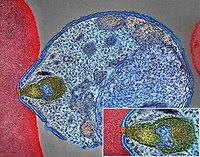
Photo from wikipedia
Public health strategies for malaria in endemic countries aim to prevent transmission of the disease and control the vector. This historical analysis considers the strategies for vector control developed during… Click to show full abstract
Public health strategies for malaria in endemic countries aim to prevent transmission of the disease and control the vector. This historical analysis considers the strategies for vector control developed during the first four decades of the twentieth century. In 1925, policies and technological advances were debated internationally for the first time after the outbreak of malaria in Europe which followed World War I. This dialogue had implications for policies in Europe, Russia and the Middle East, and influenced the broader international control agenda. The analysis draws on the advances made before 1930, and includes the effects of mosquito-proofing of houses; the use of larvicides (Paris Green) and larvivorous fish (Gambusia); the role of large-scale engineering works; and the emergence of biological approaches to malaria. The importance of strong government and civil servant support was outlined. Despite best efforts of public health authorities, it became clear that it was notoriously difficult to interrupt transmission in areas of moderately high transmission. The importance of combining a variety of measures to achieve control became clear and proved successful in Palestine between 1923 and 1925, and improved education, economic circumstances and sustained political commitment emerge as key factors in the longer term control of malaria. The analysis shows that the principles for many of the present public health strategies for malaria have nearly all been defined before 1930, apart from large scale usage of pesticides, which came later at the end of the Second World War. No single intervention provided an effective single answer to preventing transmission, but certainly approaches taken that are locally relevant and applied in combination, are relevant to today’s efforts at elimination.
Journal Title: Malaria Journal
Year Published: 2018
Link to full text (if available)
Share on Social Media: Sign Up to like & get
recommendations!